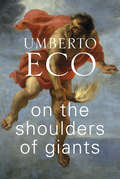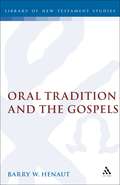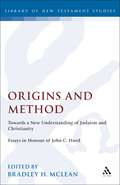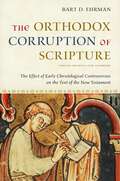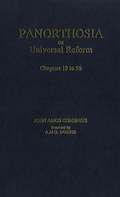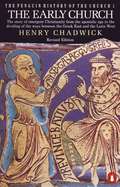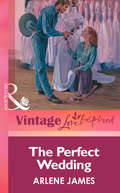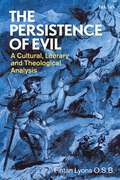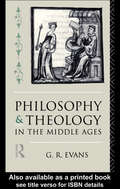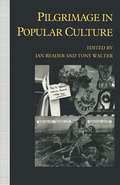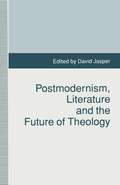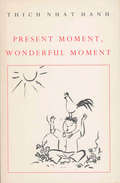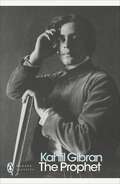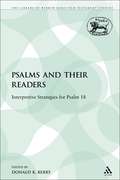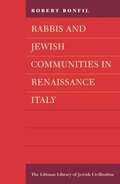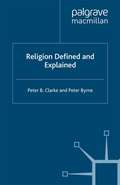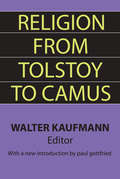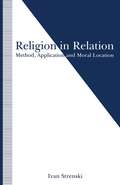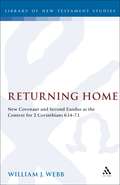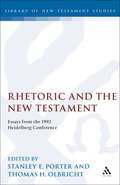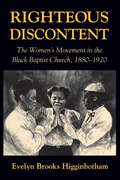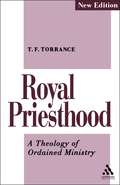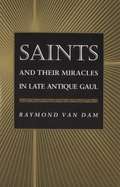- Table View
- List View
On the Shoulders of Giants: The Milan Lectures
by Umberto EcoThe final collection of essays from the internationally acclaimed and bestselling author of The Name of the Rose and The Prague Cemetery, on the subjects of art and culture.In this collection of essays we find Umberto Eco’s perennial areas of interest explored in a lively and engaging style, accompanied by beautiful reproductions of the art he discusses. In these wide-ranging pieces he explores the roots of our civilization, changing ideas of beauty, our obsession with conspiracies and the emblematic heroes of the great narrative, amongst other fascinating topics.Umberto Eco was one of the most influential, and entertaining, intellectuals of the last century, as well as being a critically acclaimed and bestselling writer of both fiction and non-fiction.
Oral Tradition and the Gospels: The Problem of Mark 4 (The Library of New Testament Studies #82)
by Barry HenautThe problem of oral tradition is well known, for without some theory of this medium no history of Jesus would be possible. This study examines Mark 4.1-34 in the light of three distinctive models of orality: Rudolf Bultmann's form-critical method, B. Gerhardsson's 'Memory and Manuscript' theory and the recent contribution of W. Kelber. The form-critically separate units in the test (allegory, parables and aphorisms) are examined on the basis of their attestation in various documents (Mark, Q, Thomas) to determine whether independent versions of these sayings can be identified and what they tell us about the oral phase and Jesus. This analysis suggests that the criteria for authenticity of 'distinctiveness' and 'multiple attestation' need to be re-examined in light of the folkloric understanding of orality.
Origins and Method--Towards a New Understanding of Judaism and Christianity: Essays in Honour of John C. Hurd (The Library of New Testament Studies)
by Bradley H. McLeanThis collection of essays is presented in honour of John C. Hurd on the occasion of his retirement as Professor of New Testament at Trinity College, Toronto, and in recognition of a distinguished career in the fields of Pauline studies and computing in the humanities. Given Professor Hurd's interest in Christian origins and methodology, it is appropriate that the contributors to this volume deal with the origin and development of various aspects of Judaism and Christianity. In particular they highlight how a greater attentiveness to method has resulted in a reshaping of our understanding of Christianity or Judaism. The volume is divided into three parts: 'New Understandings of Paul', 'New Understandings of the New Testament', and 'New Understandings of the Relationship between Judaism and Christianity'. Contributors include Walter Aufrecht, Karl Donfried, Robert Grant, John Kloppenborg, Gerd Ludemann and Wayne McCready.
The Orthodox Corruption of Scripture: The Effect of Early Christological Controversies on the Text of the New Testament
by Bart D. EhrmanVictors not only write history: they also reproduce the texts. Bart Ehrman explores the close relationship between the social history of early Christianity and the textual tradition of the emerging New Testament, examining how early struggles between Christian "heresy" and "orthodoxy" affected the transmission of the documents over which many of the debates were waged. He makes a crucial contribution to our understanding of the social and intellectual history of early Christianity and raises intriguing questions about the relationship of readers to their texts, especially in an age when scribes could transform the documents they reproduced. This edition includes a new afterword surveying research in biblical interpretation over the past twenty years.
Panorthosia by Comenius 19-26
by A.M.O. DobbiePanorthosia (Universal Reform) is the essential theme of John Amos Comenius's famous Consultation on the Reform of Human Affairs, and chapters 19-26 represent its climax. In this volume is presented the first English translation of this major work of Comenius, which was lost from about 1672 until 1934 when the Latin scholars of Czechoslovakia had it edited for publication in Prague in 1960.
The Penguin History of the Church: The Early Church (Penguin History Of The Church Ser. #Vol. 1)
by Henry ChadwickExamines the beginning of the Christian movement during the first centuries AD, and the explosive force of its expansion throughout the Roman world
The Perfect Wedding (Mills And Boon Vintage Love Inspired Ser.)
by Arlene JamesEVERYDAY MIRACLES A BRIDE AT LAST?
The Persistence of Evil: A Cultural, Literary and Theological Analysis
by Revd Fintan Lyons O.S.B.Recording the history of the belief in the existence of Satan, this book draws from the Bible, the poetry of Dante and Milton, the legend of Faust, and from modern novels and plays such as the works of Mark Twain and G.B. Shaw, and the spiritual writing of C. S. Lewis. Fintan Lyons O.S.B. chronicles the decline of that belief through the centuries as well as the attempts to treat the problem of evil philosophically, using the insights of thinkers such as Karl Barth. At the heart of this book is the attempt to synthesise or reconcile traditional belief with contemporary concern or even alarm regarding evil in the world. Lyons argues that evidence for the persistence of evil has been striking in modern times in wars and atrocities, while phenomena such as Satanic Cults and possible or real diabolical possession have continued to increase. The Catholic Church reacted to this situation in 1998 with a revision of the 1614 Rite of Exorcism, analysed in this book from both theological and psychological standpoints. By arguing that the transition from belief in Satan to personification of evil in historical regimes and characters brings contemporary culture into sharp focus, this book chronicles the history of humanity's attempt to understand the disturbing and mysterious reality of evil.
Philosophy and Theology in the Middle Ages
by G. R. EvansIn the ancient world being a philosopher was a practical alternative to being a christian. Philosophical systems offered intellectual, practical and moral codes for living. By the Middle Ages however philosophy was largely, though inconsistently, incorporated into Christian belef. From the end of the Roman Empire to the Reformation and Renaissance of the sixteenth century Christian theologians had a virtual monopoly on higher education. The complex interaction between theology and philosophy, which was the result of the efforts of Christian leaders and thinkers to assimilate the most sophisticated ideas of science and secular learning into their own system of thought, is the subject of this book. Augustine, as the most widely read author in the Middle Ages, is the starting point. Dr Evans then discusses the classical sources in general which the medieval scholar would have had access to when he wanted to study philosophy and its theological implications. Part I ends with an analysis of the problems of logic, language and rhetoric. In Part II the sequence of topics - God, cosmos, man follow the outline of the summa, or systematic encyclopedia of theology, which developed from the twelfth century as a text book framework. Does God exist? What is he like? What are human beings? Is there a purpose to their lives? These are the great questions of philosophy and religion and the issues to which the medieval theologian addressed himself. From `divine simplicity' to ethics and politics, this book is a lively introduction to the debates and ideas of the Middle Ages.
Philosophy and Theology in the Middle Ages
by G. R. EvansIn the ancient world being a philosopher was a practical alternative to being a christian. Philosophical systems offered intellectual, practical and moral codes for living. By the Middle Ages however philosophy was largely, though inconsistently, incorporated into Christian belef. From the end of the Roman Empire to the Reformation and Renaissance of the sixteenth century Christian theologians had a virtual monopoly on higher education. The complex interaction between theology and philosophy, which was the result of the efforts of Christian leaders and thinkers to assimilate the most sophisticated ideas of science and secular learning into their own system of thought, is the subject of this book. Augustine, as the most widely read author in the Middle Ages, is the starting point. Dr Evans then discusses the classical sources in general which the medieval scholar would have had access to when he wanted to study philosophy and its theological implications. Part I ends with an analysis of the problems of logic, language and rhetoric. In Part II the sequence of topics - God, cosmos, man follow the outline of the summa, or systematic encyclopedia of theology, which developed from the twelfth century as a text book framework. Does God exist? What is he like? What are human beings? Is there a purpose to their lives? These are the great questions of philosophy and religion and the issues to which the medieval theologian addressed himself. From `divine simplicity' to ethics and politics, this book is a lively introduction to the debates and ideas of the Middle Ages.
Pilgrimage in Popular Culture
by Ian Reader Tony WalterSpecially commissioned studies of popular pilgrimages - East and West, past and present, religious and 'secular - ranging from Shikoku (Japan), to Santiago de Compostela (Spain), Kosovo (Yugoslavia), Glastonbury, Anfield (UK), Flanders fields, Graceland and military pilgrimages in the USA. The book asks in what ways all these can be called pilgrimages and what their relation is to tourism and to entertainment, highlighting the enduring popularity not only of pilgrimage but also of saints and heroes.
Postmodernism, Literature and the Future of Theology (Studies in Literature and Religion)
by D. JasperThese essays are written by scholars from widely differing disciplines and traditions. Theologians, philosophers, literary critics and historians of ideas approach the question of how the judaeo-Christian tradition of theological reflection has suffered from and will negotiate the emergence of postmodern theory and practice in literature and criticism. Chapters deal with specific texts from Euripides to contemporary fiction, and with the traditions of cultural theory from Nietszche to Benjamin, to Derrida and what David Klemm identifies as the tragedy of present theology.
Present Moment, Wonderful Moment: Mindfulness Verses For Daily Living (Buddhism Ser.)
by Thich Nhat HanhPresent Moment, Wonderful Moment contains a wide range of short, evocative verses which we can use as meditations as we go about our daily affairs. Each verse is accompanied by a commentary, and the themes that are explored include: smiling at you anger; opening the window; getting dressed; serving food; greeting someone; washing vegetables; watering the garden and driving the car. Thich Nhat Hanh provides a perfect aid to mediation whatever you are during the day.
The Prophet: Penguin Classics (Penguin Modern Classics)
by Robin Waterfield Khalil GibranFirst published in the 1920's, THE PROPHET an inspirational, allegorical guide to living, the book is perhaps the most famous work of religious fiction of the Twentieth Century and has sold millions of copies in more than twenty languages. Gibran'sprotagonist, called simply 'the Prophet', delivers spiritual, yet practical, homilies on a wide variety of topics central to daily life: love, marriage and children; work and play; possessions, beauty, truth, joy and sorrow, death and many many more.
The Psalms and their Readers: Interpretive Strategies for Psalm 18 (The Library of Hebrew Bible/Old Testament Studies)
by Donald K. BerryA reader-oriented approach provides a substantially new angle of vision on Psalm 18 and Psalms study in general. Reader-based interpretation is compared to conventional methodologies by means of four separate analyses of Psalm 18: a textual study, a form-critical explication, a rhetorical study, and an experimental reader-oriented study involving the following strategies. Initially, the components of the text are considered as networks of signals for the reader. Secondly, the text's speech acts are isolated and typified. Thirdly, the ancient and contemporary contexts for the reading of the psalm are examined. The reader-oriented study culminates in two perspectives upon Psalm 18. The psalm may be read as a ritual speech act performed by the community of ancient worshippers, or as a lyric poem that each contemporary reader experiences by identification with the speaker. The concluding chapter reviews each of the methodologies, evaluating strengths and weaknesses, as well as interrelationships among methods.
Rabbis and Jewish Communities in Renaissance Italy (The Littman Library of Jewish Civilization)
by Robert BonfilFocusing on the figure of the rabbi, this book provides a vivid picture of Italian Jewry during the Renaissance. The author discusses Jewish life of the period (c.1450–1600) in its social, institutional, and cultural aspects, placing them against the backdrop of the wider Catholic environment to give an original interpretation of how Jewish cultural and religious life developed in the Renaissance context. Particular attention is given to changes in the status and functions of the rabbis and to the relations between the rabbinate and the lay leadership. Of special interest is the exploration of the cultural world of the rabbis and the broader issue of intellectual developments at the time. Essentially a translation of Part I of the Hebrew edition, which won wide acclaim for its perspective, Rabbis and Jewish Communities in Renaissance Italy has been carefully adapted for an English-speaking readership. Substantial excerpts from the appendices have been incorporated into the text so that the evidence necessary to support the arguments is easily accessible.
Religion Defined and Explained
by P. Clarke P. Byrne Scotney EvansThis book examines a selection of major types of theory explaining religion: religious, philosophical, sociological, socio-economic and psychological. It treats of the presuppositions behind such theories and the grounds of their necessity and validity. It looks at major styles in the definition of religion. It argues that the case for making religion the subject of large scale theorising has not been made and contends that the explanation of religion proceeds better by concentrating on the specifics of religious history and the interconnections between religious ideas.
Religion from Tolstoy to Camus
by Walter KaufmannWalter Kaufmann devoted his life to exploring the religious implications of literary and philosophical texts. Deeply skeptical about the human and moral benets of modern secularism, he also criticized the quest for certainty pursued through dogma. Kaufmann saw a risk of loss of authenticity in what he described as unjustied retreats into the past. This is a compilation of signicant texts on religious thought that he selected and introduced.
Religion from Tolstoy to Camus
by Walter Kaufmann Paul GottfriedWalter Kaufmann devoted his life to exploring the religious implications of literary and philosophical texts. Deeply skeptical about the human and moral benets of modern secularism, he also criticized the quest for certainty pursued through dogma. Kaufmann saw a risk of loss of authenticity in what he described as unjustied retreats into the past. This is a compilation of signicant texts on religious thought that he selected and introduced.
Religion in Relation: Method, Application and Moral Location
by Ivan StrenskiIn this collection of 11 essays the author outlines a programme of integrative, contextualized studies of religion. A number of different themes are included in these modern studies of religion.
Returning Home: New Covenant and Second Exodus as the Context for 2 Corinthians 6.14-7.1 (The Library of New Testament Studies #85)
by William WebbThe text of 2 Cor. 6.14-7.1, commonly called the 'fragment', has been the focus of much debate, due largely to its enigmatic presence within the context of 2.14-7.4. This work forges a new line of research on the problem of contextual disruption through an examination of the Old Testament traditions used within the fragment (their source, redactional focus and theology). Next, a similar traditions study is pursued in the current literary context of 2.14-7.4. A surprising degree of continuity between the fragment and its context is discovered in the use of Old Testament traditions, particularly those relating to new covenant and second exodus (exilic return) traditions. From this investigation a contextual hypothesis is proposed, along with a critique of competing contextual theories. The book concludes with two appendices which apply the contextual hypothesis to the crucial interpretative issue in 6.14a. Although the author's contextual hypothesis is not dependent upon any one interpretative solution in 6.14a, it nonetheless offers some fresh insight into the questions of who the 'unbelievers' are and what the 'unequal yoke' is.
Rhetoric and the New Testament: Essays from the 1992 Heidelberg Conference (The Library of New Testament Studies)
by Stanley E. Porter Thomas H. OlbrichtWhat role did classical rhetoric play in the writing of the New Testament? What role does classical and modern rhetoric play in interpreting the New Testament today? What role should classical and modern rhetoric play in New Testament interpretation? These and related questions are asked in this collection of over twenty essays originally delivered as papers at the 1992 Heidelberg Conference on Rhetorical Criticism of Biblical Documents. This conference, the first of several scheduled to address fundamental rhetorical issues of increasing importance in New Testament study, drew scholars from three continents and over fourteen countries, making it a truly international scholarly event and this a truly cosmopolitan publication. The authors' varying contexts resulted in a lively and challenging discussion well reflected in this volume's essays. The first part discusses rhetoric in the light of extended interpretation of a variety of New Testament texts. Luke and Acts, most of Paul's letters, and other New Testament documents are scrutinized using various rhetorical categories. In the second part, questions of rhetoric and methodology are raised. New approaches are tested in a number of essays that push the boundaries of traditional rhetorical study. These essays provide an excellent sampling of some of the major work being done in rhetorical study of the New Testament and suggest several avenues for future research.
Righteous Discontent: The Women’s Movement in the Black Baptist Church, 1880–1920
by Evelyn Brooks HigginbothamWhat Du Bois noted has gone largely unstudied until now. In this book, Evelyn Brooks Higginbotham gives us our first full account of the crucial role of black women in making the church a powerful institution for social and political change in the black community. Between 1880 and 1920, the black church served as the most effective vehicle by which men and women alike, pushed down by racism and poverty, regrouped and rallied against emotional and physical defeat. Focusing on the National Baptist Convention, the largest religious movement among black Americans, Higginbotham shows us how women were largely responsible for making the church a force for self-help in the black community. In her account, we see how the efforts of women enabled the church to build schools, provide food and clothing to the poor, and offer a host of social welfare services. And we observe the challenges of black women to patriarchal theology. Class, race, and gender dynamics continually interact in Higginbotham’s nuanced history. She depicts the cooperation, tension, and negotiation that characterized the relationship between men and women church leaders as well as the interaction of southern black and northern white women’s groups. Higginbotham’s history is at once tough-minded and engaging. It portrays the lives of individuals within this movement as lucidly as it delineates feminist thinking and racial politics. She addresses the role of black Baptist women in contesting racism and sexism through a “politics of respectability” and in demanding civil rights, voting rights, equal employment, and educational opportunities. Righteous Discontent finally assigns women their rightful place in the story of political and social activism in the black church. It is central to an understanding of African American social and cultural life and a critical chapter in the history of religion in America.
Royal Priesthood: A Theology of Ordained Ministry
by Thomas F. TorranceAn up-to-date ecumenical understanding of the Church and its ministry that cuts across divisions between Catholic and Evangelical, Anglican and Reformed, and includes the ministry of both men and women.
Saints and Their Miracles in Late Antique Gaul
by Raymond Van DamSaints' cults, with their focus on miraculous healings and pilgrimages, were not only a distinctive feature of Christian religion in fifth-and sixth-century Gaul but also a vital force in political and social life. Here Raymond Van Dam uses accounts of miracles performed by SS. Martin, Julian, and Hilary to provide a vivid and comprehensive depiction of some of the most influential saints' cults. Viewed within the context of ongoing tensions between paganism and Christianity and between Frankish kings and bishops, these cults tell much about the struggle for authority, the forming of communities, and the concept of sin and redemption in late Roman Gaul.Van Dam begins by describing the origins of the three cults, and discusses the career of Bishop Gregory of Tours, who benefited from the support of various patron saints and in turn promoted their cults. He then treats the political and religious dimensions of healing miracles--including their relation to Catholic theology and their use by bishops to challenge royal authority--and of pilgrimages to saints' shrines. The miracle stories, collected mainly by Gregory of Tours, appear in their first complete English translations.
